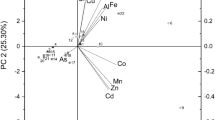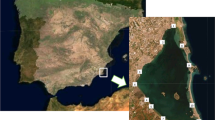Abstract
Undaria pinnatifida and Sargassum muticum are the most abundant invasive edible algae species that have colonized the hard substrate around Venice. The contents of Ca, Mg, Fe, Zn, Cu, Mn, Sr, Pb, Cr, Al, Co, Cd, Ni, As, Hg and Ba, were investigated by ICP-MS in seaweed samples collected (Spring 2013) in six different sites of Venice. A correlation analysis of the results was performed. Sargassum muticum exhibited overall higher contents than U. pinnatifida for many of the considered elements. The elemental contents in both species were in ranges comparable to those reported for seaweeds subjected to anthropogenic impact. Considering the French legislation as a working reference for Pb, Cd and inorganic As limits for seaweed for human consumption, the present results pointed out that in both species Pb content was on average higher than the French limits, whereas the Cd and Hg contents were much lower than the same legislation limits.



Similar content being viewed by others
References
Badocco D, Lavagnini I, Mondin A, Pastore P (2015a) Effect of multiple error sources on the calibration uncertainty. Food Chem 177:147–51
Badocco D, Lavagnini I, Mondin A, Tapparo A, Pastore P (2015b) Limit of detection in the presence of instrumental and non-instrumental errors: study of the possible sources of error and application to the analysis of 41 elements at trace levels by inductively coupled plasma-mass spectrometry technique. Spectrochim Acta B- 107:178–84
Barillari A (1981) Distribuzione dei sedimenti superficiali nel bacino meridionale della Laguna di Venezia. Atti Ist Ven Sci Nat 139:87–109
Barreiro R, Picado L, Real C (2002) Biomonitoring heavy metals in estuaries: a field comparison of two brown algae species inhabiting upper estuarine reaches. Environ Monit Assess 75:121–34
Basu A, Molinaroli E (1994) Toxic metals in Venice lagoon sediments: model, observation, and possible removal. Environ Geol 24:203–16
Besada V, Andrade JM, Schultze F, González JJ (2009) Heavy metals in edible seaweeds commercialised for human consumption. J Mar Syst 75:305–13
Caliceti M, Argese E, Sfriso a, Pavoni B (2002) Heavy metal contamination in the seaweeds of the Venice lagoon. Chemosphere 47:443–54
Casas G, Scrosati R, Luz Piriz M (2004) The invasive kelp Undaria pinnatifida (Phaeophyceae, Laminariales) reduces native seaweed diversity in Nuevo Gulf (Patagonia, Argentina). Biol Invasions 6:411–6
Cochran JK, Frignani M, Salamanca M et al (1998) Lead-210 as a tracer of atmospheric input of heavy metals in the northern Venice Lagoon. Mar Chem 62:15–29
Conti ME, Cecchetti G (2003) A biomonitoring study: trace metals in algae and molluscs from Tyrrhenian coastal areas. Environ Res 93:99–112
Curiel D, Rismondo A, Marzocchi M, Solazzi A (1994) Distribuzione di Undaria pinnatifida (Harvey) Suringar (Laminariales, Phaeophyta) nella Laguna di Venezia. Lav Soc Ven Sc Nat 19:121–6
Curiel D, Bellemo G, Marzocchi M (1996) New records of marine algae in the lagoon of Venice. G Bot Ital 130:352
Curiel D, Bellemo G, Marzocchi M et al (1998) Distribution of introduced Japanese macroalgae Undaria pinnatifida, Sargassum muticum (Phaeophyta) and Antithamnion pectinatum (Rhodophyta) in the Lagoon of Venice. Hydrobiologia 385:17–22
Curiel D, Marzocchi M (2010) Stato delle conoscenze nella laguna di Venezia di due alien species : Undaria pinnatifida e Sargassum muticum. Lav Soc Ven Sc Nat 35:93–106
Favero N, Frigo M (2002) Biomonitoring of metal availability in the southern basin of the Lagoon of Venice (Italy) by means of macroalgae. Water Air Soil Pollut 140:231–46
Fung A, Hamid N, Lu J (2013) Fucoxanthin content and antioxidant properties of Undaria pinnatifida. Food Chem 136:1055–62
Gargiulo MG, De Masi F, Tripodi G (1992) Sargassum muticum (Yendo) Fensholt (Phaeophyta, Fucales) is spreading in the lagoon of Venice (northern Adriatic Sea). G Bot Ital 126:259
Gibbons JD (1976) Non-parametric methods for quantitative analysis. Holt Rhinehart and Winston, New York
Giusti L (2001) Heavy metal contamination of brown seaweed and sediments from the UK coastline between the Wear River and the Tees River. Environ Int 26:275–86
Khan N, Ryu KY, Choi JY, Nho EY, Habte G, Choi H, Kim MH, Park KS, Kim KS (2015) Determination of toxic heavy metals and speciation of arsenic in seaweeds from South Korea. Food Chem 169:464–70
Keiji I, Kanji H (1989) Seaweed: chemical composition and potential food uses. Food Rev Int 5:101–44
Laib E, Leghouchi E (2012) Cd, Cr, Cu, Pb, and Zn concentrations in Ulva lactuca, Codium fragile, Jania rubens, and Dictyota dichotoma from Rabta Bay, Jijel (Algeria). Environ Monit Assess 184:1711–8
Lobban CS, Harrison PJ (1994) Seaweed ecology and physiology. Cambridge University Press, Cambridge
Llorente-Mirandes T, Ruiz-Chancho MJ, Barbero M, Rubio R, López-Sánchez JF (2011) Determination of water-soluble arsenic compounds in commercial edible seaweed by LC-ICPMS. J Agric Food Chem 59:12963–8
MacArtain P, Gill CIR, Brooks M, Campbell R, Rowland IR (2007) Nutritional values of edible seaweeds. Nutr Rev 65:535–43
Magistrato alle Acque (1990) Carta della distribuzione della salinità in Laguna di Venezia. Consorzio Venezia Nuova, Servizio Informativo
Malea P, Haritonidis S (2000) Use of the green alga Ulva rigida C. Agardh as an indicator species to reassess metal pollution in the Thermaikos Gulf, Greece, after 13 years. J Appl Phycol 12:169–76
Malea P, Kevrekidis T (2014) Trace element patterns in marine macroalgae. Sci Total Environ 494-495C:144–57
Marzocchi M, Curiel D, Scattolin M (2003) Variazioni del fitobenthos di substrato duro della Laguna di Venezia tra il mare e la terraferma. Boll Mus Civ St Nat Venezia 54:5–17
Rismondo A, Volpe S, Curiel D, Solazzi A (1993) Segnalazione di Undaria pinnatifida (Harvey) Suringar a Chioggia (Laguna Veneta). Soc Ven Sc Nat 18:329–30
Rismondo A, Volpe S, Curiel D, Helman P, Marzocchi M, Solazzi A (1994) Osservazioni preliminari su Undaria pinnatifida (Harvey) Suringar, recentemente segnalata a Chioggia (Laguna di Venezia). Biol Mar Medit 1:377–8
Rodríguez-Castañeda AP, Sánchez-Rodríguez I, Shumilin EN, Sapozhnikov D (2006) Element concentrations in some species of seaweeds from La Paz Bay and La Paz Lagoon, south-western Baja California, Mexico. J Appl Phycol 18:399–408
Romarís-Hortas V, García-Sartal C, Barciela-Alonso MC, Moreda-Piñeiro A, Bermejo-Barrera P (2010) Characterization of edible seaweed harvested on the Galician coast (northwestern Spain) using pattern recognition techniques and major and trace element data. J Agric Food Chem 58:1986–92
Ryan S, McLoughlin P, O’Donovan O (2012) A comprehensive study of metal distribution in three main classes of seaweed. Environ Pollut 167:171–7
Saez CA, Lobos MG, Macaya EC et al (2012) Variation in patterns of metal accumulation in thallus parts of Lessonia trabeculata (Laminariales; Phaeophyceae): implications for biomonitoring. PLoS One 7:e50170
Sánchez-Rodríguez I, Huerta-Diaz MA, Choumiline E, Holguín-Quiñones O, Zertuche-González JA (2001) Elemental concentrations in different species of seaweeds from Loreto Bay, Baja California Sur, Mexico: implications for the geochemical control of metals in algal tissue. Environ Pollut 114:145–60
Sfriso A, Facca C (2013) Annual growth and environmental relationships of the invasive species Sargassum muticum and Undaria pinnatifida in the lagoon of Venice. Estuar Coast Shelf Sci 129:162–72
Smit AJ (2004) Medicinal and pharmaceutical uses of seaweed natural products: a review. J Appl Phycol 16:245–62
Topcuoǧlu S, Güven KC, Balkis N, Kirbaşoǧlu Ç (2003) Heavy metal monitoring of marine algae from the Turkish coast of the Black Sea, 1998–2000. Chemosphere 52:1683–8
Wallenstein FM, Couto RP, Amaral AS, Wilkinson M, Neto AI, Rodrigues AS (2009) Baseline metal concentrations in marine algae from São Miguel (Azores) under different ecological conditions—urban proximity and shallow water hydrothermal activity. Mar Pollut Bull 58:438–43
Acknowledgments
The financial support of the Italian Ministry of University and Research (MIUR, PRIN project n. 2010AXENJ8) is gratefully acknowledged.
Author information
Authors and Affiliations
Corresponding author
Rights and permissions
About this article
Cite this article
Marzocchi, M., Badocco, D., Piovan, A. et al. Metals in Undaria pinnatifida (Harvey) Suringar and Sargassum muticum (Yendo) Fensholt edible seaweeds growing around Venice (Italy). J Appl Phycol 28, 2605–2613 (2016). https://doi.org/10.1007/s10811-016-0793-8
Received:
Revised:
Accepted:
Published:
Issue Date:
DOI: https://doi.org/10.1007/s10811-016-0793-8




